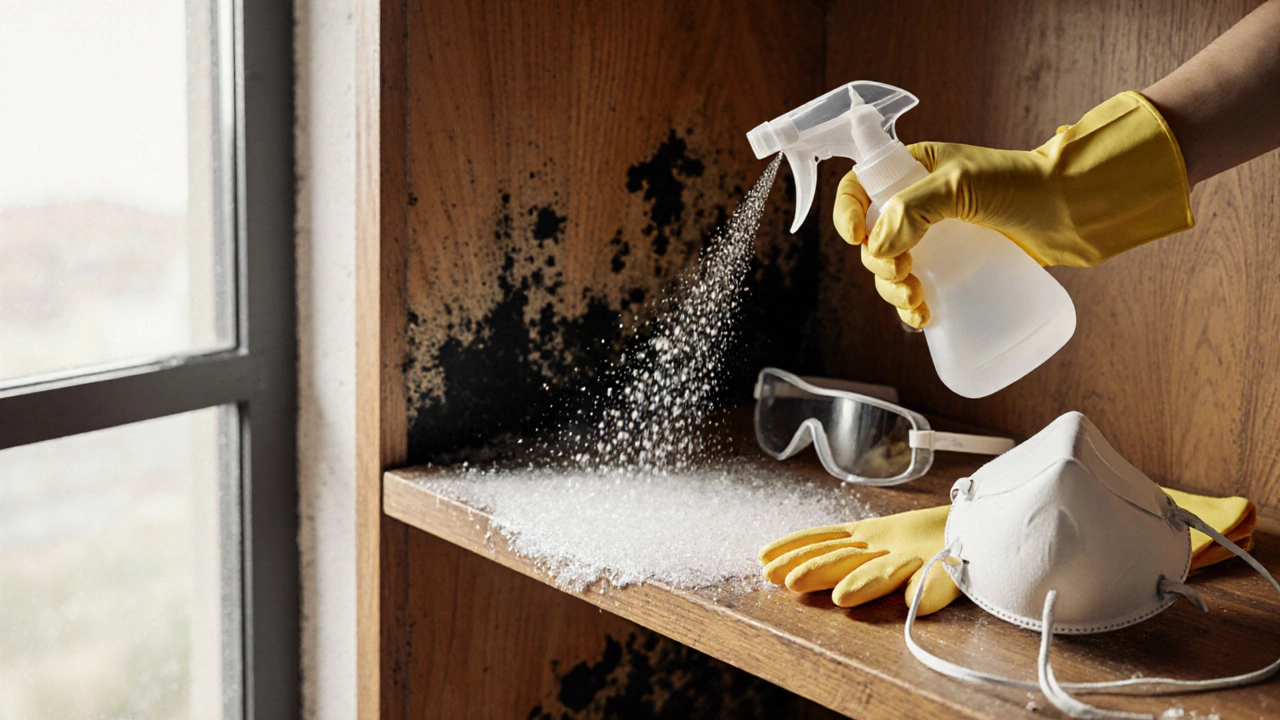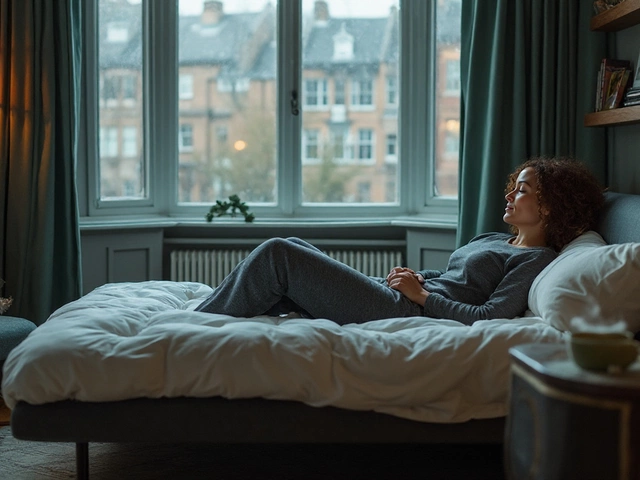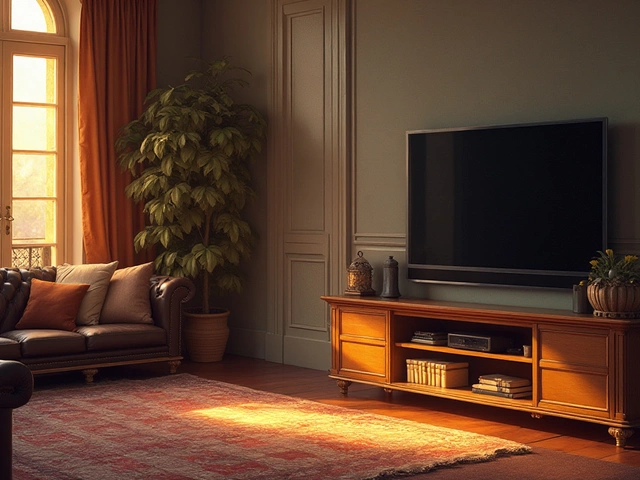Mold Treatment Calculator
Choose Your Furniture Type
Current Humidity Level
Ideal mold prevention requires humidity below 60% RH
Current humidity: 40%
When mold shows up on wooden shelves, Mold is a type of fungus that thrives in damp conditions, stains surfaces and can release allergens that affect health. You’ve probably tried a spray, a wipe, maybe even a dab of lemon juice, yet the black spots keep coming back. The good news? There are a handful of treatments that really do kill mold spores completely - and they’re safe enough for most storage furniture when you follow a few simple steps. Below is a no‑fluff guide that covers the science, the best products, and the everyday habits that keep mold from ever setting foot in your cabinets again.
Key Takeaways
- Bleach (5‑6% sodium hypochlorite) and 3% hydrogen peroxide are the only household chemicals proven to achieve 100% spore kill on non‑porous wood finishes.
- For porous finishes, combine a fungicidal spray with a UV‑C lamp to penetrate deeper layers.
- Control humidity below 60% and use silica gel packets or a dehumidifier to prevent re‑growth.
- Apply a mold‑resistant paint or sealant after cleaning to create a barrier.
- Safety first - wear gloves, eye protection and ensure good ventilation when using harsh chemicals.
Understanding Mold on Furniture
Most storage units are made of wood, particleboard or metal. Wood and particleboard are hygroscopic - they absorb moisture from the air. When relative humidity climbs above 65% for a prolonged period, the fibers swell and create tiny air pockets where mold spores can settle. Once established, the fungus feeds on the organic binders in the wood, producing black, green or white patches.
Two things matter when you’re trying to eradicate mold:
- Kill the spores completely - half‑dead spores can rebound when conditions improve.
- Remove or neutralize the mycotoxins left behind, because they can irritate skin and lungs even after the fungus is dead.
That’s why a surface wipe with a mild detergent rarely solves the problem - it just moves the spores around.
Why Common Cleaners Fall Short
Many people reach for all‑purpose cleaners, vinegar, or even baking soda. While these agents can clean surface grime, they lack the oxidative power needed to break the sturdy cell walls of mold spores. For example, white vinegar has a pH of about 2.5, which can inhibit growth but won’t guarantee a 100% kill rate on porous wood.
To achieve true elimination, you need an agent that creates enough free radicals to oxidize the spore’s essential proteins. That’s where Bleach (a solution of sodium hypochlorite that releases chlorine radicals capable of destroying fungal cell membranes) and Hydrogen peroxide (a 3% aqueous solution that produces hydroxyl radicals, a potent oxidizer that penetrates porous surfaces) step in.
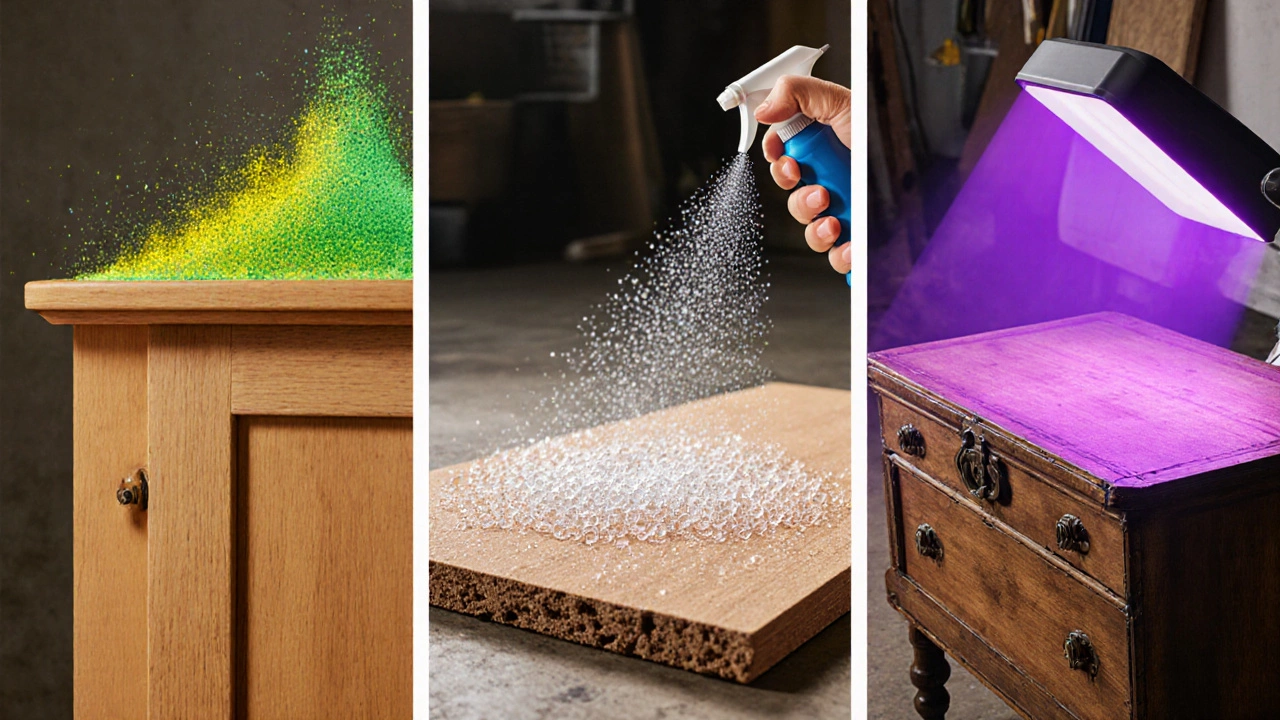
100% Effective Mold‑Killing Methods
Below is a quick‑reference table that rates each method on three criteria: spore kill rate, material safety, and ease of use. The data comes from the U.S. Environmental Protection Agency (EPA) and several peer‑reviewed studies on indoor fungal remediation.
| Treatment | Spore Kill Rate | Material Compatibility | Application Ease |
|---|---|---|---|
| Bleach (5‑6% sodium hypochlorite) | 100% on non‑porous surfaces | Safe on sealed wood, metal; can discolor unfinished wood | Mix & spray, wait 10 min, rinse |
| Hydrogen peroxide (3%) | 99‑100% on porous & non‑porous | Generally safe on most finishes, minimal odor | Spray, let sit 10 min, wipe |
| Vinegar (5% acetic acid) | ~80% on non‑porous, <70% on porous | Very safe on all surfaces | Apply undiluted, scrub, no rinse needed |
| Tea tree oil (5% solution) | ~90% on non‑porous | Safe, pleasant scent, but pricey | Spray, wait 30 min, wipe |
| UV‑C Light (254 nm) | ~95% on exposed surfaces, <80% on deep pores | Non‑contact; no chemical residue | Position lamp 2 ft away, run 5‑15 min |
Bleach - The Gold Standard for Quick Kill
Grab a gallon of regular household bleach (5‑6% sodium hypochlorite). Dilute it 1:10 with water in a spray bottle. Spray directly onto the moldy area, ensuring full coverage. Let it sit for at least ten minutes - that’s the time the chlorine radicals need to break every spore wall. After the wait, rinse with clean water and dry thoroughly.
Tip: If your storage unit has a clear lacquer finish, test a hidden spot first; bleach can strip the topcoat.
Hydrogen Peroxide - The Gentle Heavy‑Hitter
Hydrogen peroxide works especially well on particleboard and unfinished wood because the liquid can seep into the pores. Use a 3% solution straight from the pharmacy bottle. Spray liberally, let sit for ten minutes, then wipe with a clean microfiber cloth. No rinsing needed - the peroxide breaks down into water and oxygen, leaving no residue.
UV‑C Light - The Non‑Chemical Backup
For items you can’t saturate with liquid (think of a vintage wooden chest), a portable UV‑C lamp does the trick. Position the lamp about 2 feet away and expose each side for 5‑15 minutes depending on lamp power. UV‑C creates DNA‑damage in the spores, effectively neutralizing them.
Note: UV‑C only works on surfaces it can see. Combine it with a chemical soak for deep‑seated mold.
Tea Tree Oil & Vinegar - When You Prefer Natural Options
Mix 1 cup of white vinegar with 1 teaspoon of tea tree oil in a spray bottle. This combo gives you up to 90% kill on non‑porous surfaces while smelling better than bleach. It’s great for closed cabinets where you don’t want a chlorine odor.
Remember, natural doesn’t always mean 100% effective. Use these only if the mold patch is light and the humidity is already under control.
Step‑by‑Step Guide to Clean Mold on Storage Furniture
- Assess the damage. If the mold has soaked through more than a ¼‑inch of wood, consider discarding the piece - deep penetration is hard to fully eradicate.
- Ventilate the area. Open windows, run a fan, and wear a N‑95 mask to avoid inhaling spores.
- Choose your treatment. For sealed wood, bleach is fastest. For unfinished or porous surfaces, hydrogen peroxide is safer.
- Apply the solution. Spray until the surface is wet, avoid pooling.
- Wait. Let the chemical sit for ten minutes; this is the “kill window.”
- Scrub gently. Use a soft‑bristle brush or non‑abrasive pad to dislodge dead spores.
- Rinse (if needed). For bleach, rinse with clean water; for peroxide, skip rinsing.
- Dry completely. Use a clean towel and then a dehumidifier or silica gel packets to pull remaining moisture.
- Seal the wood. Apply a mold‑resistant paint or polyurethane sealant to create a barrier.
Follow these steps and you’ll achieve a true mold removal that lasts.
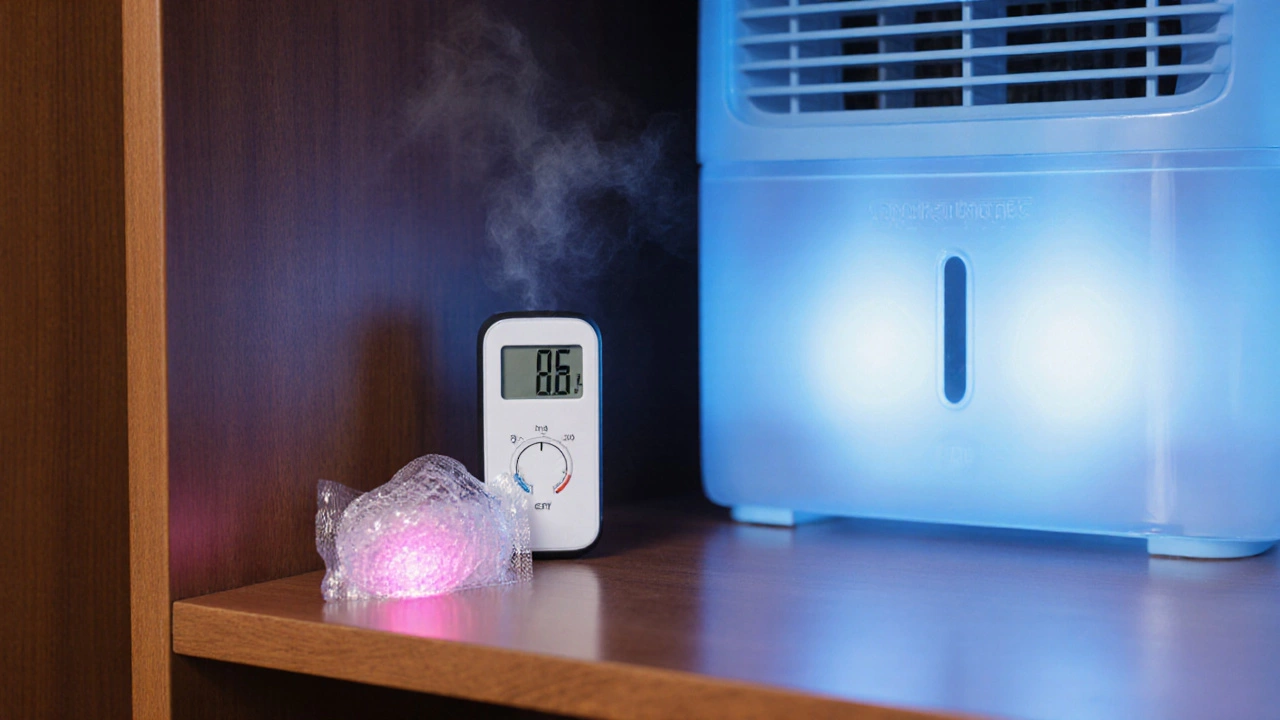
Preventing Future Mold Outbreaks
Even the best cleaning won’t help if you keep feeding mold with moisture. Here are three habits that keep your storage spaces dry:
- Humidity the amount of water vapor in the air, measured as relative humidity (RH) should stay below 60% year‑round. Use a hygrometer to monitor.
- Place a Dehumidifier an appliance that extracts moisture from indoor air, often measured in pints per 24 hours in basements or closets during rainy seasons.
- Scatter a few packets of Silica gel a desiccant that absorbs moisture, commonly found in small breathable pouches on shelves; replace them when they turn pink.
Combine these with occasional airflow (open doors, rotate items) and you’ll rarely see mold again.
Quick Checklist Before You Store Anything
- Clean and dry the container.
- Apply a thin layer of mold‑resistant spray (available at hardware stores).
- Place silica gel packets inside.
- Store in a climate‑controlled room where RH < 60%.
Frequently Asked Questions
Can I use bleach on unfinished wood?
Bleach can discolor unfinished wood and may weaken the fibers over time. For raw wood, hydrogen peroxide or a 1:1 solution of vinegar and water is safer.
How long does mold stay dead after treatment?
If you keep humidity below 60% and seal the surface, the spores stay inactive indefinitely. Re‑growth only happens when moisture returns.
Is UV‑C safe for furniture finishes?
UV‑C doesn’t leave chemical residues, but prolonged exposure can yellow some laminates. Keep exposure under 15 minutes per side and test a hidden spot first.
Do silica gel packets prevent mold entirely?
They dramatically reduce humidity inside a closed container, but they’re not a substitute for proper room‑wide humidity control.
What protective gear should I wear?
Wear nitrile gloves, safety goggles, and an N‑95 respirator. If you’re using bleach, ensure the area is well‑ventilated.
Got more questions? Drop a comment below - the community loves swapping tips for a mold‑free home.
